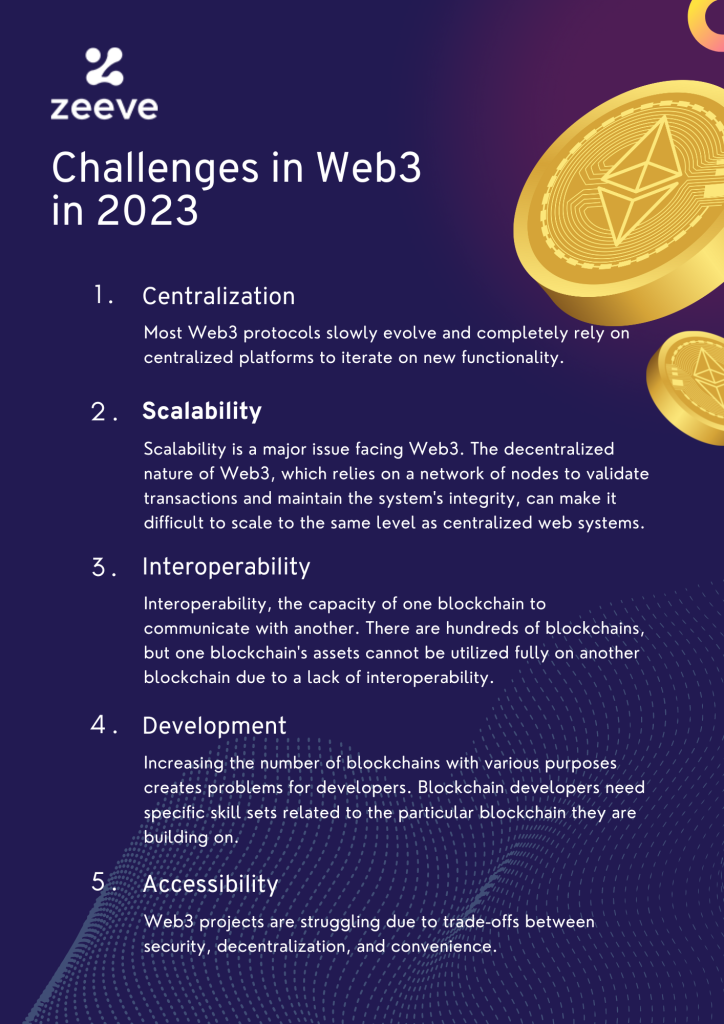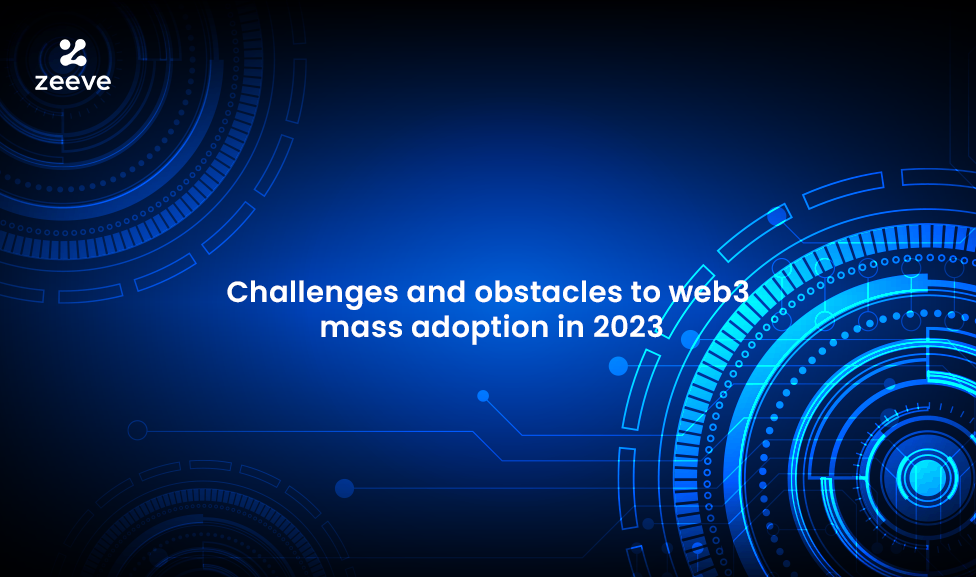Web3, a vision for a new internet based on blockchain technology. Welcome to the decentralized future: an open and level playing field of ideas, data and applications that are revolutionizing how we interact with each other online. Here, freedom reigns supreme as users have more control than ever before in exploring their digital world. Web3 projects are building at the fastest pace. With each passing day, we see more startups in the space and more spikes in the numbers of new entrants in NFT space and DAOs, indicating that the strong potential of web3 is being increasingly realized across the globe. A recent report predicts the Web3 market size will grow by 44.9% from 2022 to 2030. But is it that easy to jump into it? Not really! The technology being in its early days makes it a little challenging for masses to adopt it at a go. People are still tinkering with ideas and integration as well as implementation for enterprise blockchain technology remains comparatively low despite the buzz it has created.
Web 1.0 dominated the internet during the 1990s when we only had consumers. It was only in the early 2000s when we started witnessing a gradual shift from web2 to more of web3 alternatives as more and more people started attaching value to giving ownership to content producers who churns out relevant digital content. And this content was not generated just by big corporations and powerful organizations but even the masses. Social media platforms, blogs, video-sharing platforms, and whatnot- almost every platform saw abundance of content being generated! Everything we use today is Web 2.0. But it gave rise to mega internet companies having a monopoly and huge amounts of user data.
This concern gave rise to blockchain technology, and the Web3 movement started, giving back power to individual internet users instead of big companies. Since the technology is still in its initial phase, it makes us ask if we can see the mass adoption of Web3 in 2023.
In this blog, we will know about the challenges and obstacles to Web3 adoption.
5 Challenges and Obstacles to Web3 Adoption
Web2 started with its challenges. Web3 is a better approach, but it also runs into a few problems. This blog is all about those Web3 challenges and possible solutions for the adoption of Web3. Gear up, and keep reading!
Centralization
The entire Web3 narrative has been set towards decentralization. Having smart contracts, DeFi, NFTs, and metaverses, Web3 has come up with a bold approach. But to make this blockchain technology accessible, Web3 protocols are linked around a centralized ecosystem to run their servers.
Most Web3 protocols slowly evolve and completely rely on centralized platforms to iterate on new functionality. Many of those cryptocurrency wallets such as Phantom and the popular ones such as Metamask, come as browser extensions, ushering with complex security challenges.
Most famous names like Opensea, the largest NFT marketplace, or Metamask, a cryptocurrency wallet with more than 10 million monthly active users, rely on centralized infrastructure companies like Infura, a backend, and Infrastructure-as-a-service provider. Most cryptocurrency users depend on their wallets to preserve their private keys required while transacting. Would you still call it completely decentralized?
Scalability
Scalability is a major issue facing Web3. The decentralized nature of Web3, which relies on a network of nodes to validate transactions and maintain the system’s integrity, can make it difficult to scale to the same level as centralized web systems. Ethereum co-founder Vitalik Buterin coined the term scalability trilemma, also called blockchain trilemma, which means that no blockchain can achieve security, decentralization, and scalability altogether. Any blockchain can only select two at any moment.
One of the main factors contributing to the scalability issue is the size of the blockchain, which can grow quickly as more transactions are added. It can lead to slower transaction times and higher fees, as nodes must process and check each and every transaction before it can be integrated to the blockchain.
Furthermore, Bitcoin can process 7 transactions per second, while Ethereum can process 20 transactions per second, while Visa can handle 24,400 transactions per second. Did you smile? 🙂
Energy consumption of decentralized web also makes it difficult to scale in an environmentally sustainable manner. However, there’s no easy solution for that, but developers and researchers are trying to solve this problem through different approaches, including layer2 solutions and new consensus mechanisms.
Interoperability
We have one more issue, and that is interoperability. The ability of one blockchain to transfer data & communicate each other. There are hundreds of blockchains, but one blockchain’s assets cannot be utilized fully on another blockchain due to a lack of interoperability.
There are also concerns about security and trust when it comes to interoperability. Ensuring that data is securely transferred and properly validated when moving between different blockchain networks can be a challenge.
However, we have Web3 projects like Injective, Cosmos, and Polkadot, which build blockchain ecosystems that allow interoperability and are particularly designed for this purpose. To achieve interoperability several ways are there such as mashed API, and the Network of Networks Method. The process of attaining interoperability is complex but not impossible and more and more projects will launch in upcoming years.
Development
Hundreds of issues and hundreds of blockchains. Many of the well-known networks are trying to resolve various development concerns in the Web3 space, each pitching itself for its unique use cases. Some have decentralization as their selling point; some are quick and inexpensive. The application development pipeline is sluggish when compared to Web3. Mainly in Web3, the developers have to maintain client-SDKs for application developers. This development cycle is time-taking for protocol developers.
Increasing the number of blockchains with various purposes creates problems for developers. It is crucial for blockchain developers to have skills that are relevant to the blockchain network they are working on. For example, you might need to know “Solidity” to develop on Ethereum or “Rust” to develop on Solana. Currently, 4000+ developers are building on Ethereum, while 1000+ developers are working on different projects in Solana.
Accessibility
Existing Web3 projects make it easy for Web2 users to shift to their platforms. And remember, people can’t embrace what they can’t figure out. If there will lesser accessibility, people will not be able to interact with many of the Web3 projects.
Web2 apps like Instagram and Facebook are user-friendly and easily accessible compared to Web3 projects. Google, Youtube, Facebook and other Web2 platforms have excellent UI/UX for their users. Web3 products, on the other hand, are still struggling due to trade-offs between security, and convenience. The more appropriate and user-friendly a Web3 product is, the less secure it might be. In recent years, there has been a rise in cryptojacking cases. Thus, security-related obstacles on Web3 need to be solved to make to more accessible for mainstream business.

How can we tackle the Web3 Challenges?
To solve the problems of Web3, initial work needs to be done on the UI and UX of the system. A better interface will take away the confusion for the users. With the current Web2 technology, we can use the existing standards and modify them further for the Web3 ecosystem.
The bridges among the platforms should be easy-to-use and access. Most importantly, the audit of the smart contract should be hassle-free. The companies have to resolve the issues timely, and third-party testing makes a platform more robust. To pave the path for Web3 adoption, creating consumable and educational content still plays a vital role. The more awareness, the better the Web3 accessibility.
Here at Zeeve , we believe that there is a path towards successful efficiency by understanding and addressing the unique issues posed by blockchain-based technologies, which means making sure that developers are building decentralized applications that work for users and marketplaces through strong network management and security protocols.
Summing it all Up
Challenges do not end here. It might hurt you, but most Web3 projects no longer have value in the market. Creators are struggling to establish and come up with new utilities. The use cases of Web3 products should be clear enough for the masses to understand what products they are, what problems they are solving, and, most importantly, how they can benefit a user. Entrepreneurs who are able to identify market problems and develop products that fit these concerns are needed.
In light of the fact that people like to pay for comfort and solutions, they’ll prefer to use what helps them solve their problems easily. No one would pay for the product that would frustrate them. In order for Web3 to be adopted by the masses, the user experience must be improved.
We cannot neglect the importance of Web3 education in the wide adoption of Web3. There should be proper content available concerning the future of Web3 on navigating through dApps and different Web3 projects so that it is not limited to people working in the blockchain ecosystem.
Providing challenges in Web3 and highlighting the benefits of Web2 doesn’t mean that Web2 doesn’t encounter any challenges. It’s just that it has gained more mainstream adoption, and people were able to solve the challenges of the masses to utilize the technology better. The only way to ensure that Web3 achieves mainstream adoption in 2023 is that more builders and adopters collectively make an effort to solve the ongoing challenges of blockchain technology. The more users are bullish on this decentralized technology, the more it’ll help Web3 to grow.
Partnering with Zeeve
Looking to unlock the potential of Web 3.0 within your business? Zeeve is here to help! As a trusted leader in Blockchain Infrastructure Management platform, they provide their thousands of customers with immense features and benefits that will revolutionize enterprise operations. Want to learn more about how you can benefit from partnering up with these experts? Then follow them on Twitter or Telegram for updates – alternatively, schedule yourself an obligation-free call today and start enjoying the advantages of Web 3.0 tomorrow!
For more details, schedule a free call.






















